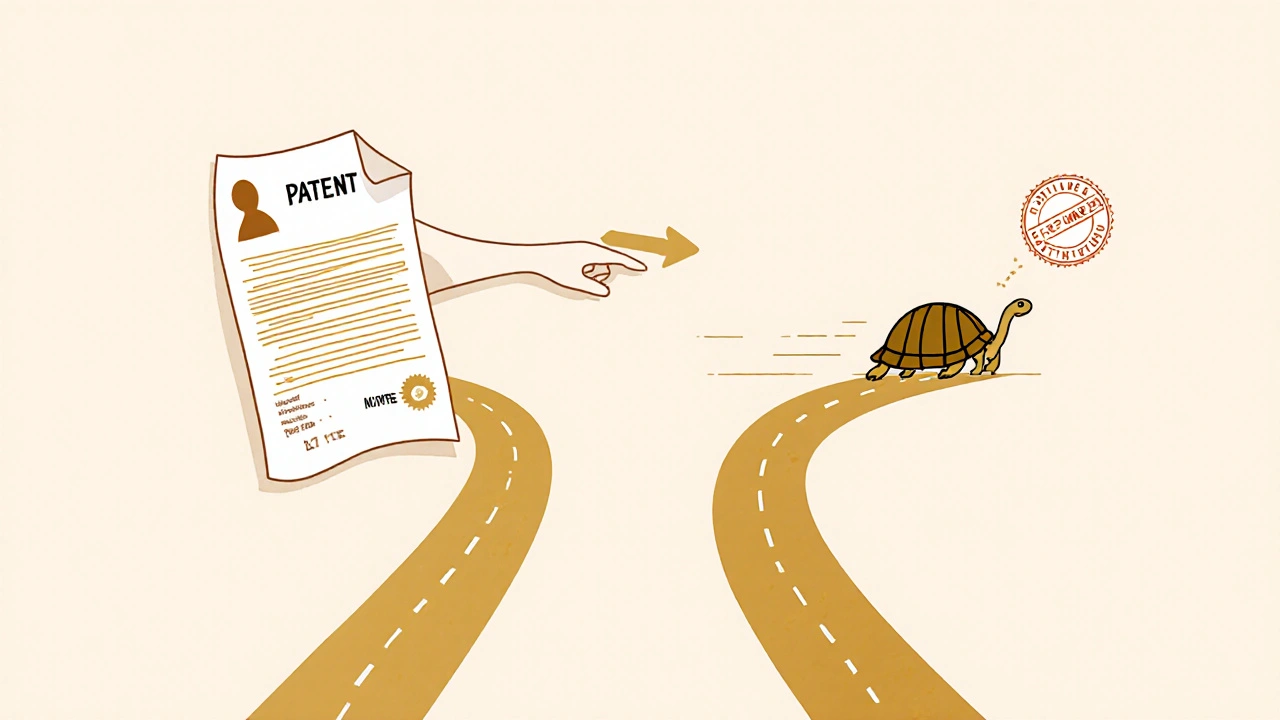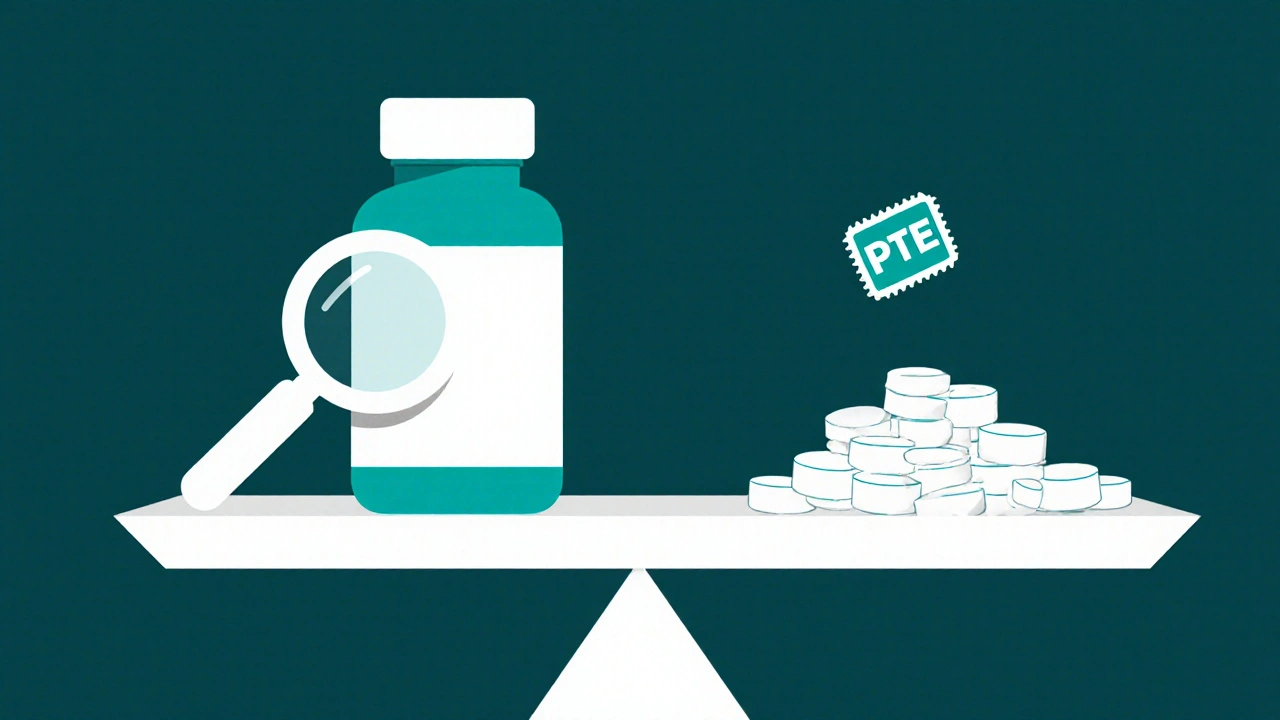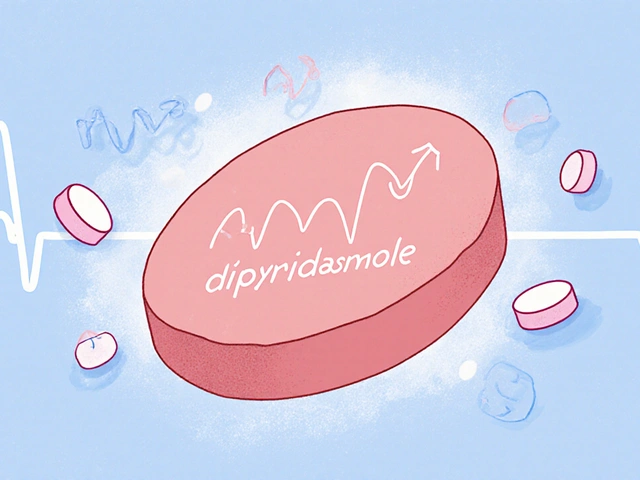What is Patent Term Restoration (PTE)?
Patent Term Restoration is a legal tool in the U.S. that lets pharmaceutical companies get back some of the time they lost waiting for FDA approval. It's not about renewing a patent that expired because fees weren't paid. It's about making up for the years a drug sat in regulatory limbo-where the patent was active but the product couldn't be sold.
Imagine you file a patent for a new cancer drug in 2010. You spend the next 12 years running clinical trials, submitting paperwork, and waiting for the FDA to say yes. By the time you get approval in 2022, your 20-year patent clock is almost done. Without PTE, you’d have just a few years left to sell your drug before generics flood the market. With PTE, you might get five extra years-giving you time to recoup your $2.6 billion investment, as reported by the Tufts Center for the Study of Drug Development.
How PTE Works: The Hatch-Waxman Act
The system was created by the Hatch-Waxman Act of 1984. It was a compromise: let generic drugs enter faster, but give innovators a fair shot at recovering lost time. The law covers human drugs, medical devices, food additives, and animal drugs. It’s managed in two parts: the FDA figures out how long the regulatory review took, and the USPTO calculates how much time to add back to the patent.
The formula looks complex, but here’s the simplified version: PTE = Total regulatory delay minus delays caused by the applicant. If the FDA took 8 years to approve your drug, but you were slow to submit documents for 2 years, you’d get 6 years added. But there’s a cap: you can’t get more than 5 years added, and the total patent life after extension can’t go past 14 years from FDA approval.
Who Qualifies for PTE?
Not every patent gets extended. To qualify, you need:
- A patent that’s still active (not expired)
- A product that went through a regulatory review period (like FDA approval)
- No prior extension on that patent
- Application filed within 60 days of FDA approval
It only applies to one patent per product. If you have five patents covering the same drug, you pick the one that gives you the biggest benefit. Most companies pick the patent that covers the active ingredient, not a secondary one like a new pill coating or delivery method.
But here’s the catch: the FDA’s Orange Book lists over 22,000 patent entries. Of those, 83% of new drugs have at least one patent eligible for extension. That means most big pharma companies are applying-and getting-PTEs.

Why PTE Matters: Money, Market, and Monopoly
Branded drugs make up just 12% of prescriptions filled in the U.S., but they generate 78% of the industry’s revenue, according to IMS Health. Why? Because patents keep generics out. PTE stretches that exclusivity.
After a drug gets PTE, it holds onto 92% of its market share, per FTC data. Once generics arrive, that drops to 37%. That’s billions in lost revenue. The Congressional Budget Office estimates PTE adds $4.2 billion a year to U.S. drug spending. For companies, it’s not just fair compensation-it’s survival. A single blockbuster drug can earn $1 billion a year. Losing even two years to generics can mean the difference between profit and bankruptcy.
But critics say the system is being stretched too far. A 2022 study in the Yale Law and Policy Review found that 91% of drugs that got PTE still held monopolies years later-thanks to secondary patents, litigation, and other tactics. And according to JAMA, 78% of PTE applications involve secondary patents, not the original compound. That’s not what Congress intended.
How to Apply: The Process and Pitfalls
Applying for PTE isn’t a form you fill out in an hour. It’s a marathon of documentation.
First, you need a complete paper trail. The FDA requires day-by-day proof you were moving the product forward. That means:
- Every submission to the FDA
- Every email or letter with regulators
- Meeting notes, lab logs, timelines
According to a 2023 survey by the Intellectual Property Owners Association, 67% of patent attorneys call PTE applications “high-risk, high-reward.” Why? Because 12.7% of them get denied-mostly for not proving continuous progress. One big pharma patent specialist on Reddit said the most common mistake is thinking milestone dates are enough. They’re not. You need to show you didn’t pause.
And you’ve got just 60 days after FDA approval to file. Miss that window? You lose the chance forever. Many companies use a six-month suspension rule (37 C.F.R. § 1.103) to delay the application until a reissue patent is granted or litigation is settled.

Recent Changes and Future Trends
The rules are tightening. In January 2024, the FDA released new guidance on “due diligence,” making it harder to claim full credit for delays. A 2024 Federal Circuit ruling (Eli Lilly v. USPTO) set stricter standards for proving you weren’t dragging your feet during pre-approval. Analysts say this could shave 8-12 months off average extensions.
At the same time, PTE is expanding. In 2016, the 21st Century Cures Act added regenerative medicine products to the list. And biologics-complex drugs made from living cells-are now the fastest-growing category. In 2018, only 19% of PTE applications were for biologics. By 2023, that jumped to 34%, according to the FDA’s annual report.
The FDA is also planning to move the whole process online by Q2 2026. Right now, applications are paper-heavy. A digital system could cut processing time from 217 days to under 100.
Is PTE Fair? The Bigger Debate
Supporters say PTE is essential. Developing a new drug takes over a decade and costs billions. Without PTE, no company would take the risk. The system was designed to balance innovation and access-and it’s worked for 40 years.
But critics point to the numbers: over 1,200 extensions granted between 2010 and 2020. That’s 1,200 extra years of exclusivity. And with the proposed Preserve Access to Affordable Generics and Biosimilars Act now in Congress, lawmakers may finally try to limit how PTE is used.
The Government Accountability Office is set to release a major review in December 2025. If they find PTE is fueling drug price hikes more than intended, changes could come fast.
What’s Next for Drug Patents?
PTE isn’t going away. But its future depends on whether it’s seen as a tool for innovation-or a tool for monopoly. For now, it remains a critical lever for pharmaceutical companies. If you’re in the industry, understanding PTE isn’t optional. It’s part of your business plan. For patients and payers, it’s a key piece of the drug pricing puzzle.
Can a patent be extended more than once under PTE?
No. The Hatch-Waxman Act allows only one patent term extension per product. Even if a drug has multiple patents covering different aspects-like the chemical compound, formulation, or method of use-only one can receive an extension. Companies choose the patent that gives them the most commercial benefit.
Does PTE apply to generic drugs?
No. PTE is only available to the original innovator who held the patent and went through the regulatory approval process. Generic manufacturers don’t need to wait for FDA approval-they rely on the innovator’s data. That’s why they can enter the market faster after the patent expires or the extension ends.
What’s the difference between PTE and PTA?
PTE (Patent Term Extension) makes up for delays caused by the FDA during drug approval. PTA (Patent Term Adjustment) compensates for delays caused by the USPTO during patent examination. They’re two separate systems. A patent can have both, but they’re calculated differently and serve different purposes.
Can I apply for PTE if my patent expired before FDA approval?
No. The patent must still be active when you apply. If it expired before FDA approval, you’re out of luck. That’s why companies often file for PTE right before expiration. If they’re still waiting for approval, they can request an Interim Extension, which gives temporary protection until the final decision comes in.
How long does it take to get a PTE approved?
The FDA takes about 217 days on average to process a PTE application, according to their 2024 report. But the full timeline includes time for the USPTO to review the FDA’s findings and issue the extension. Total time from filing to approval can be 8-12 months, depending on complexity and documentation quality.
Do other countries have PTE systems like the U.S.?
Yes. The European Union, Japan, Canada, Australia, and South Korea all have similar systems to compensate for regulatory delays. But the rules vary. The EU allows up to five years of extension, but caps total protection at 15 years from initial market authorization. Japan limits extensions to five years and requires the patent to be filed before the drug enters clinical trials.






6 Comments
Patent term extension is just regulatory capture dressed in legal jargon. Pharma spends $2.6B to develop a drug? So what? That’s a cost of doing business, not a moral claim to monopoly pricing. The real innovation is in gaming the system-not science.
Let’s be real-PTE isn’t about fairness, it’s about corporate theater. You file a patent in 2010, spend 12 years in FDA purgatory, then act like you’re the martyr who sacrificed everything? Nah. You had a team of lawyers drafting applications while your scientists were running trials. The FDA didn’t delay you-you delayed yourself by not prepping for submission until month 10. And don’t get me started on the 83% of drugs with eligible patents-half of those are for coating pills or changing the tablet shape. Congress never meant for this to become a patent thicket lottery. Now we’ve got biologics getting extensions like they’re coupon clippers at Walmart. And don’t even mention the ‘interim extensions’-that’s just legal loophole bingo. The FDA’s new ‘due diligence’ rules? Too little, too late. They’re still letting companies hide behind ‘meeting notes’ and ‘email trails’ like those are holy texts. If you didn’t have a daily logbook with timestamps and witness signatures, you didn’t deserve the extension. And the USPTO? They rubber-stamp everything because they’re understaffed and underfunded. This whole system is a Rube Goldberg machine designed to keep prices high while pretending it’s about innovation. The fact that 91% of PTE drugs still hold monopolies years later? That’s not a feature. That’s a bug. And the 21st Century Cures Act? That was a gift to biotech lobbyists, not patients. The digital transition by 2026? Great. Maybe then we’ll stop losing applications in the mail. But I’ll believe it when I see it. Until then, PTE is just the pharmaceutical industry’s way of saying: ‘We’re not rich enough.’
...and yet... no one ever talks about the FDA’s backlogs being *deliberately* inflated... I mean... think about it... who benefits from 217-day delays?... Big Pharma... they *want* the clock to run... so they can stack extensions... and then... they lobby to make the rules even *more* ambiguous... it’s all a game... a very expensive, very quiet game... and we’re the ones paying... with our insulin... our cancer meds... our children’s futures... I mean... *really*... how many times do we need to be told ‘it’s for innovation’ before we realize innovation is just a synonym for ‘profit maximization’?...
Stop acting like PTE is some evil scheme. If you’re gonna spend billions and a decade developing a drug, you better get a return. Otherwise you get no drugs. Simple as that. Generic makers get to free ride on the R&D. That’s capitalism. Deal with it.
There’s a moral dimension here we can’t ignore. The system was designed to incentivize risk, not to create permanent monopolies. When a drug’s patent is extended for a pill coating or a delivery mechanism that adds no therapeutic value, we’re not protecting innovation-we’re protecting greed. Patients aren’t asking for free medicine. They’re asking for reasonable access. The 1,200 extensions granted since 2010? That’s 1,200 years of delayed competition. That’s not a feature of the system. That’s a failure of oversight. We need transparency-not just in the application process, but in how the FDA and USPTO collaborate. And we need Congress to stop treating pharma like a sacred cow. This isn’t about stifling innovation. It’s about restoring balance.
bro the whole pte thing is just a scam the fda takes 2 years to approve anything because theyre understaffed and then big pharma uses that as an excuse to extend patents for 5 more years and then they jack up prices and call it fair... its not fair its just corporate theft